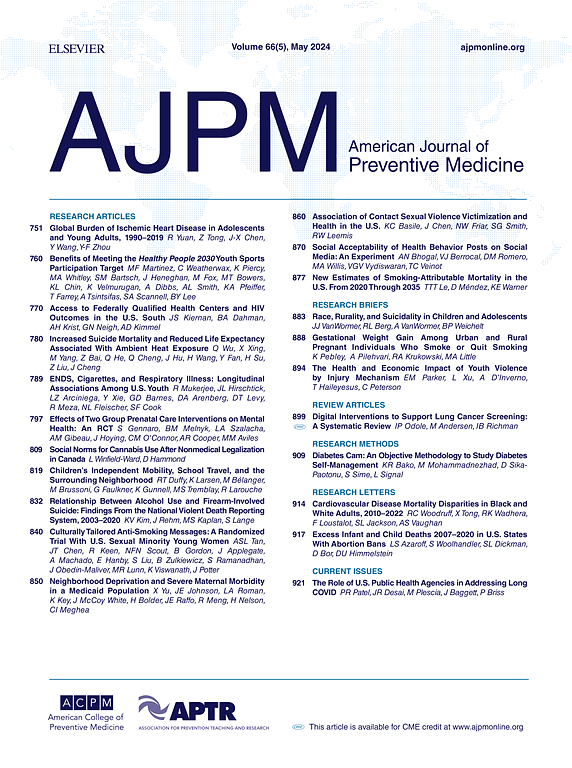Psychosocial and Structural Correlates of Tobacco Use Among Black Young Adults
IF 4.5
2区 医学
Q1 MEDICINE, GENERAL & INTERNAL
引用次数: 0
Abstract
Introduction
U.S.- and foreign-born Black young adults often have different cultural backgrounds and experiences that can an affect the types of, extent of, and response to the psychosocial stressors encountered. This study examined whether psychosocial and structural stressors are similarly related to any and polytobacco (i.e., 2 or more tobacco products) use among subgroups of Black young adults in the U.S.
Methods
Cross sectional data were collected in 2023 from 445 Black young adults (aged 18–25 years) in the U.S. Stratified regression models were used to examine the association of psychosocial (mental health adversity, race-related adversity, concerns about societal issues) and structural (food insecurity and housing insecurity) stressors with past 6-month any and polytobacco use among U.S.- and foreign-born Black young adults.
Results
Race-related adversity was associated with higher odds of polytobacco use (than odds of nonuse) among both U.S.- (AOR=1.36, 95% CI=1.06, 1.74) and foreign- (AOR=2.18, 95% CI=1.18, 4.03) born Black young adults. Food insecurity was associated with higher odds of polytobacco use among foreign-born Black young adults (AOR=1.92, 95% CI=1.13, 3.27) and any tobacco use among both U.S.- (AOR=1.36, 95% CI=1.04, 1.79) and foreign- (AOR=1.47, 95% CI=1.01, 2.17) born Black young adults. However, concern about societal issues was associated with reduced odds of polytobacco use in both groups.
Conclusions
In all models, experiences of racism and discrimination (race-related adversity) were linked to higher odds of polytobacco use, whereas concern about societal issues was protective. However, there were nativity differences in the association of food insecurity with any and polytobacco use. Findings support the need for culturally/ethnically conscious tobacco prevention strategies that address the underlying psychosocial and structural drivers of tobacco use among Black young adult subgroups.
黑人青少年吸烟的社会心理和结构相关因素。
导言:在美国和外国出生的黑人青年(YA)通常具有不同的文化背景和经历,这可能会影响他们所遇到的社会心理压力的类型、程度和反应。本研究探讨了社会心理和结构性压力因素是否与美国黑人青年亚群体中任何烟草和多烟草(即两种或两种以上烟草制品)的使用有类似关系:采用分层回归模型研究了美国和外国出生的黑人青年中社会心理(心理健康逆境、种族相关逆境、对社会问题的担忧)和结构性(食物不安全和住房不安全)压力因素与过去 6 个月任何烟草和多种烟草使用情况的关系:在美国(aOR=1.36,95% CI=1.06,1.74)和外国出生(aOR=2.18,95% CI=1.18,4.03)的黑人青年中,与种族有关的逆境与使用(与不使用)多种烟草的较高几率相关。粮食不安全与外国出生的黑人青年亚裔使用多种烟草的几率较高(aOR=1.92,95% CI=1.13,3.27)以及美国出生的黑人青年亚裔(aOR=1.36,95% CI=1.04,1.79)和外国出生的黑人青年亚裔(aOR=1.47,95% CI=1.01,2.17)使用任何烟草的几率较高有关。然而,对社会问题的关注与这两个群体使用多种烟草的几率降低有关:在所有模型中,种族主义和歧视经历(种族相关逆境)与较高的多烟草使用几率相关,而对社会问题的关注则具有保护作用。然而,在食物不安全与吸烟和多烟草使用的关系上,存在着民族差异。研究结果表明,有必要制定具有文化/种族意识的烟草预防策略,以解决黑人青年亚群体中烟草使用的潜在社会心理和结构性驱动因素。
本文章由计算机程序翻译,如有差异,请以英文原文为准。
求助全文
约1分钟内获得全文
求助全文
来源期刊

American Journal of Preventive Medicine
医学-公共卫生、环境卫生与职业卫生
CiteScore
8.60
自引率
1.80%
发文量
395
审稿时长
32 days
期刊介绍:
The American Journal of Preventive Medicine is the official journal of the American College of Preventive Medicine and the Association for Prevention Teaching and Research. It publishes articles in the areas of prevention research, teaching, practice and policy. Original research is published on interventions aimed at the prevention of chronic and acute disease and the promotion of individual and community health.
Of particular emphasis are papers that address the primary and secondary prevention of important clinical, behavioral and public health issues such as injury and violence, infectious disease, women''s health, smoking, sedentary behaviors and physical activity, nutrition, diabetes, obesity, and substance use disorders. Papers also address educational initiatives aimed at improving the ability of health professionals to provide effective clinical prevention and public health services. Papers on health services research pertinent to prevention and public health are also published. The journal also publishes official policy statements from the two co-sponsoring organizations, review articles, media reviews, and editorials. Finally, the journal periodically publishes supplements and special theme issues devoted to areas of current interest to the prevention community.
 求助内容:
求助内容: 应助结果提醒方式:
应助结果提醒方式:


